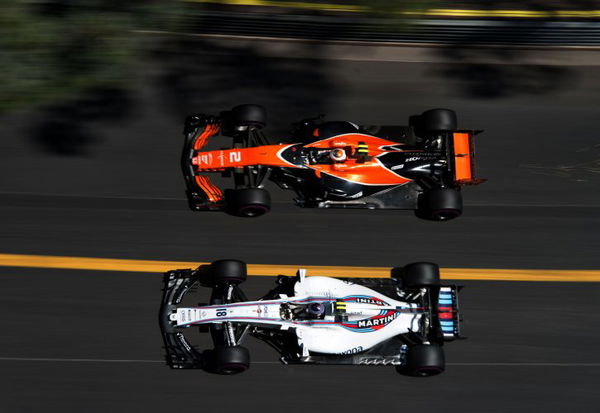

When Williams went through its gradual fall from grace from being Formula 1’s dominant force to an also-ran, comparisons were made with the fortunes of Tyrrell, which from the 1970s to the 1990s went from a world championship contender to a backmarker.
So if Williams was once the new Tyrrell, is McLaren the new Williams? Right now, it should simply be aspiring to be worthy of that tag.
ADVERTISEMENT
Article continues below this ad

McLaren may turn its nose up at such a comparison, since Williams is ‘only’ a customer team in F1 and it has got used to keeping its realistic ambitions in check.
But Williams is a team that has gone about getting its house in order and understanding that it needs to rebuild, rather than repeatedly declaring that it remains a powerhouse and that it’s just a matter of time before it’s on the championship trail again.
McLaren should take note.
After years of being the works Mercedes team in F1, dating back to 1995, McLaren knew that the arrival of a fully fledged Silver Arrows team in 2010 would spell the end of its special relationship with the German manufacturer. In that respect, seeking out a works engine deal of its own – and eventually ending up with Honda – made sense. It was worth a shot. But that shot has failed, and it’s time for McLaren to stop kidding itself that it is just a sleeping giant waiting for the alarm clock to go off. The batteries are probably dead by now. It is no longer purely a matter of time before McLaren wins again. It’s a case of ‘if’, not ‘when’.
When the Honda deal was announced in May 2013 there was talk of the move giving McLaren “a bedrock of being one of the big teams”. The only thing big about it right now is its size, and its level of underachievement.
By December 2014, Ron Dennis was talking about “domination” being the objective. It created good excuses for raiding the archives to find iconic images of Ayrton Senna and Alain Prost in the late 1980s, but the novelty has now worn completely off.

Yet in its third year, the McLaren-Honda partnership seems further away from achieving anything of note than ever. Last year’s sixth place in the constructors’ championship is starting to look worryingly like a high-water mark.
And after two years of consistent messages that receiving customer engines is a waste of time, since you can’t win the championship, McLaren has opened up to appreciate the fact that surely life as a frontrunning customer team has got to be a more worthwhile existence than toiling at the back with engines that are too slow and/or too unreliable? Why would you want an exclusive deal on that?

Williams’s path through the 21st century shows that this is no easy task. Once it lost BMW for 2006 it went on a long, winding, relatively fruitless journey through the next few years, bouncing between engine suppliers. Even winning a grand prix in 2012 – while using Renault V8 power – wasn’t enough to steer the team fully back on course.

The Renault partnership ended up being short-lived, coming after two stints with Cosworth and a Toyota deal in the middle. If anything, it was the Japanese arrangement that offered a clear example of Williams understanding that its star had waned. When it accepted signing Kazuki Nakajima as part of its Toyota deal, it led to comparisons with the late-1980s, when Williams lost the dominant Honda engines because it refused to take his father Satoru as part of the package.
Back then it was a big fish in the F1 pond and it managed to bounce back, landing Renault after a painful year with Judd engines. By the late-2000s, it knew it was in no such position to turn down similar terms from Japan.
Following yet another disastrous start to an F1 season, McLaren is coming around to this way of thinking. Mercedes, and surprisingly Ferrari too, has been sounded out about a customer engine deal. If a deal falls into place, you’d have to think that in the current competitive order, with Red Bull surprisingly far back from Mercedes and Ferrari, there would be a window of opportunity for McLaren to establish itself as the third best on the grid right now. Red Bull is a customer team as well, and while its struggles with Renault power show the pitfalls of being at the mercy of a supplier, it has at least managed to win races occasionally.
Surely the men and women who work so hard at McLaren wouldn’t mind being a top 4 contender atleast, even if it came with a guarantee of not being able to make the step up to battle for championships. That’s got to be a lot more rewarding than working just as hard to see your cars trundle around off the pace while your drivers complain on the radio and your bosses spin their wheels, managing expectations in public.
But what of Honda? It has committed a lot of money to McLaren, which the lack of sponsors on the MCL32 suggests would be hard to replace. Would be easy for it to just walk away so easily? The Sauber deal is there atleast on paper but the internal storm at Hinwil

With the exception of the late-1980s/early-90s high point, Honda’s F1 history is not littered with success stories. And it could be argued that its turbo engine programme only came to the fore once pioneers in that area such as Renault and BMW started to ease away from F1. Even if Honda’s rise to prominence played a part in those rivals backing away, when it was at its most dominant it didn’t face much competition, and it didn’t take long for Renault to surpass it as the leading force when normally aspirated engines returned for 1989.
Its return in the 21st century produced just one mixed-weather victory, and although it developed what became the 2009 world championship-winning Brawn GP BGP 001 before withdrawing at the end of 2008, many believe that chassis would probably not have enjoyed the success it did had Brawn not been able to swap out Honda engines for Mercedes.
So McLaren finds itself standing at a crossroad, well it has been standing there for a year but refused to acknowledge it, a crossroad between midfield success and front runner ambitions. And it’s acknowledgment has come at beautiful time as new engine regulations are set to be enforced in 2021, it gives McLaren 3 years to run a customer engine deal,
ADVERTISEMENT
Article continues below this ad

ADVERTISEMENT
Article continues below this ad
enjoy better standings in the Constructors Table and better finances that come with it, get better with its chassis and maybe acquire a few sponsors too and then use its position as a powerhouse to ink a better deal when the engine situation resets.
But perhaps it’s potential engine suppliers and on-track rivals know this possibility (on the basis of the news that Ferrari and Mercedes both are not interested in supplying engines to McLaren) and hence are trying their best to make sure that come 2020, McLaren is nothing but a hollow image of its glorious past, no longer a powerhouse to even dream about getting back on top and if that’s the case then perhaps McLaren’s acknowledgement has come too late unfortunately.
ADVERTISEMENT
ADVERTISEMENT
ADVERTISEMENT
ADVERTISEMENT

